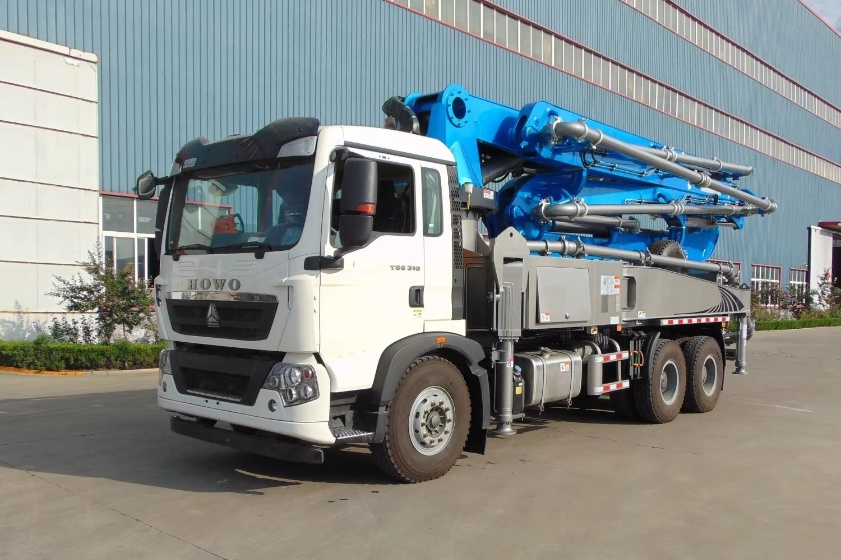News
Cleaning method of concrete pump with S tube valve
Jun. 28, 2024
In concrete pumping construction, concrete cleaning is an essential and important step after pumping. A good cleaning method can not only clean the delivery pipeline, but also deliver all the concrete in the pipeline to the pouring site, which not only does not waste concrete, but is also economical and environmentally friendly. There are three main water washing methods commonly used for S-tube valve concrete pumps, which are introduced as follows.
1 Direct water pumping method
1) Check the wear between the cutting ring and the eye plate, which is the key to determining the success or failure of the direct water pumping cleaning method. If the cutting ring and the eye plate are not seriously worn, the distance between the cutting ring and the eye plate is less than 0.1mm, and there is no groove scratch more than 1mm between them, the direct water pumping method can be used.
2) After pumping the concrete, pump 0.15~0.25m\+3 of mortar with a water-cement ratio of 1:1.5 or 1:2, then fill the distribution valve with water, start pumping, and pump the concrete to the pouring site until clear water flows out of the output end of the delivery pipe. If the pipeline is short and the cleaning effect is good, the cleaning process ends here.
3) When the pipeline is long or the cleaning effect is not good, open the hopper discharge door, turn on the reverse pump, and rinse the hopper and distribution valve. If pumping upward and the height is greater than 20m, you can use a wooden hammer to knock on the bottom elbow of the vertical part. If the knocking sound is low, you need to disassemble the elbow and pour out the large aggregate that may be accumulated.
4) Close the discharge door and pump clean water until clean water flows out from the output end of the conveying pipe. The advantage of the direct water pumping method is that there is no need to disassemble the discharge pipe and add a cleaning ball, which saves time, and pumping is easier to succeed, especially for cleaning shorter pipelines.
Its disadvantages: ① The water consumption is large and the pumping water must be continuous, and the water is easy to drain at the pouring site; ② If there is a vertical upward pipeline, the elbow must usually be disassembled; ③ When the conveying pipeline is long, it is easy to have residue in the pipeline; ④ The sealing requirements of the distribution valve are stricter.
2 Disassembly of the discharge pipe method
1) After pumping the concrete, reverse pump 1 to 2 cycles to eliminate the pressure in the conveying pipe. If pumping upward, the stop valve must be closed first to prevent concrete backflow, and then the discharge pipe is removed.
2) Open the hopper discharge door, and reverse the pump to flush the distribution valve, concrete cylinder and concrete in the hopper.
3) Take out some concrete from the mouth of the first 6B or 5B delivery pipe and insert a water-soaked cleaning ball or cylindrical cleaning piston.
4) Close the distribution valve discharge door, open the stop valve if there is one, and pump clean water until the piston is pumped out from the output end of the delivery pipe.
The advantage of the dismantling the discharge pipe method is that the pipeline is cleaned more cleanly, the flow rate of the water source can be lower, and it can be suspended. The disadvantage is that it is difficult to reconnect the discharge port after it is disassembled, which is time-consuming and laborious.
3-add piston method
1) Use 10 to 20 cement bags to roll into a column with a diameter slightly smaller than the diameter of the delivery cylinder, a slightly pointed head, and a length of about 400mm. Tie it with fine wire, and lightly tie the cleaning ball with wire to the tail of the column and soak it with water.
2) After pumping the concrete, reverse pump 1 to 2 cycles to eliminate the pressure in the delivery pipe, and press the button to make the concrete cylinder piston retreat to the last point. If pumping upward and there is a stop valve, it must be closed first to prevent concrete backflow.
3) Remove the discharge pipe, open the hopper discharge door, and reverse pump to rinse the distribution valve, concrete cylinder and concrete in the hopper.
4) Close the hopper discharge door, add water to the hopper, and when the water is added to 2/3 of the height of the concrete cylinder diameter, put the head of the column into the concrete cylinder in the direction of the distribution valve, and use a wooden crowbar about 1m long and 30mm in diameter to hold the column, and continue to add water to the height of the center line of the mixing shaft.
5) Remove the crowbar, quickly start pumping, and continue to add water until the column is pumped out from the output end of the delivery pipe. The advantage of the piston method is that the pipeline is cleaned more cleanly, the flow rate of the water source can be lower and can be paused, and the trouble of removing the discharge port and the bend is reduced. The disadvantage is that the operation requirements are high and the distribution valve can easily cut off the column.
The above three concrete pump water washing methods have their own advantages and disadvantages. The most reliable one is the dismantling of the material pipe method, and the simplest one is the piston method. If the conveying distance is short, the direct water pumping method is also a good choice. The specific method should be determined according to the actual situation of the construction. In short, it should be both effective and economical.







